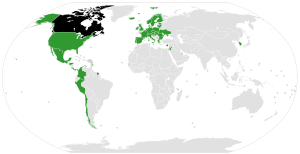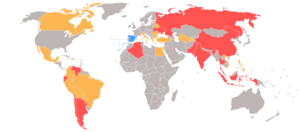Free-trade agreements of Canada

Canada is regularly described as a trading nation as its total trade is worth more than two-thirds of its GDP (the second highest level in the G7 after Germany).[1][2] Of that total trade, roughly 75% is done with countries which are part of free-trade agreements with Canada, primarily the United States through NAFTA.[3] By the end of 2014, Canada bilateral trade hit C$1 trillion for the first time.[4]
The North American Free Trade Agreement among Canada, the United States, and Mexico came into force on January 1, 1994, creating the largest free-trade region in the world. By 2014, the NAFTA area GDP was estimated to be over C$20 trillion with a market encompassing 474 million people.[5][6] Building on that success, Canada continues to negotiate and has concluded free-trade agreements with more than 40 countries, most recently with South Korea, which represents Canada's first FTA with a partner in the Asia-Pacific region. As of 2016, Canada has also concluded two trade agreements that are potentially bigger than NAFTA: the Comprehensive Economic and Trade Agreement (CETA) with the European Union and the twelve-nation Trans-Pacific Partnership (TPP).[7] On 21 September 2017, CETA was provisionally applied, immediately eliminating 98 per cent of EU's tariff lines on Canadian goods.[8] Since CETA's provisional application, Canada has free trade agreements with all of the G7 countries except Japan.
World Trade Organization
| Part of a series on the |
| Economy of Canada |
|---|
| Economic history of Canada |
| Sectors |
|
| Economy by province |
| Economy by city |
Canada is an original member of the World Trade Organization (WTO) since January 1, 1995.
Free-trade agreements
Free-trade agreements in force or provisionally in force
The following is a list of countries Canada has current FTAs with. First is the name of the agreement. In parentheses, the abbreviation is given if applicable, countries involved if not previously stated, and the date of coming into force.[7]
- Canada-U.S. Free Trade Agreement (Signed 12 October 1987, entered into force 1 January 1989, later superseded by NAFTA)
- North American Free Trade Agreement (Entered into force 1 January 1994, includes Canada, U.S. and Mexico)
- Canada-Israel Free Trade Agreement (Entered into force 1 January 1997, modernization ongoing)
- Canada-Chile Free Trade Agreement (Entered into force 5 July 1997)
- Canada-Costa Rica Free Trade Agreement (Entered into force 1 November 2002, modernization ongoing)
- Canada-European Free Trade Association Free Trade Agreement (Iceland, Norway, Switzerland and Liechtenstein; entered into force 1 July 2009)
- Canada-Peru Free Trade Agreement (Entered into force 1 August 2009)
- Canada-Colombia Free Trade Agreement (Signed 21 November 2008, entered into force 15 August 2011; Canada's ratification of this FTA had been dependent upon Colombia's ratification of the "Agreement Concerning Annual Reports on Human Rights and Free Trade Between Canada and the Republic of Colombia" signed on 27 May 2010)
- Canada-Jordan Free Trade Agreement (Signed on 28 June 2009, entered into force 1 October 2012)
- Canada-Panama Free Trade Agreement (Signed on 14 May 2010, entered into force 1 April 2013)
- Canada-Honduras Free Trade Agreement (Signed on 5 November 2013, entered into force on 1 October 2014)
- Canada-South Korea Free Trade Agreement (Signed on 11 March 2014, entered into force 1 January 2015)
- Canada-Ukraine Free Trade Agreement (CUFTA) (signed 11 July 2016, entered into force on 1 August 2017)
- Comprehensive Economic and Trade Agreement (concluded 5 August 2014, signed 30 October 2016, provisionally applied on 21 September 2017[9])
- Canadian Free Trade Agreement (CFTA, signed July 1, 2017), free trade within Canada.[10]
Free-trade agreements concluded
- Trans-Pacific Partnership (signed 4 February 2016)[7]
Free-trade agreements under re-negotiation
NAFTA re-negotiations began in August, 2017 following demands made by President Donald Trump.[11]

The third round took place in Ottawa in September 2017 with discussions on Intellectual Property (IP) with Canada and the U.S. holding widely diverging viewpoints.[13] The Office of the United States Trade Representative under U.S. Trade Representative Robert E. Lighthizer have kept Canada under their Section 306 Watch List[12]:5 because of their "deep" concerns about "in transit" or "transshipped" "pirated and counterfeit goods".[12]:62 The U.S. is "deeply troubled" by the "broad interpretation of an ambiguous education-related exception to copyright".[12]:62 The Centre for International Governance Innovation (CIGI) published a special report in September 2017, "NAFTA 2.0 and Intellectual Property Rights" in which the authors, composed of a "community of scholars and practitioners", addressed the "requirements of a modernized NAFTA Chapter 17". They noted that Canada meets "international obligations when it comes to respect for copyright and patents and has largely addressed long-standing U.S. demands regarding additional reforms".[14]:7
The round of talks in May, 2018 were suspended when both Mexico and Canada rejected U.S. demands.[11] The next round of talks is scheduled for July 26 in Washington.[11] This year, 2019 brings the next general election and the big talk amongst the Liberals is to avoid alienating Quebec since 23% of the House of Commons is populated by Quebec, Canada.[15]
Free-trade agreements under negotiation
The following is a list of countries Canada is currently making FTA negotiations with. First is the name of the agreement. In parentheses is the abbreviation if applicable and the countries involved if not previously stated.
Canada is negotiating bilateral FTAs with the following countries and trade blocs:[7]
- Caribbean Community (CARICOM)
- Dominican Republic
- Guatemala, Nicaragua and El Salvador
- India
- Japan[16]
- Morocco
- Singapore
Canada was previously involved in negotiations to create the following regional trade blocks:
Free-trade agreements under exploratory discussions
Canada is undertaking discussions of bilateral or multilateral FTAs with the following countries and trade blocs, although formal negotiations have not yet begun:[7]
Foreign investment promotion and protection agreements
A foreign investment promotion and protection agreement (FIPA) is an agreement to promote foreign investing.
FIPAs in force
The following is a list of FIPAs in force, including date of entry into force.[7]
- Canada-Argentina (29 April 1993)
- Canada-Armenia (29 March 1999)
- Canada-Barbados (17 January 1997)
- Canada-Benin (18 January 2013)
- Canada-Cameroon (16 December 2016)
- Canada-China (1 October 2014)
- Canada-Costa Rica (29 September 1999)
- Canada-Côte d'Ivoire (14 December 2015)
- Canada-Croatia (30 January 2001)
- Canada-Czech Republic (22 January 2012)
- Canada-Ecuador (6 June 1997)
- Canada-Egypt (3 November 1997)
- Canada-Guinea (27 March 2017)
- Canada-Hong Kong (6 September 2016)
- Canada-Hungary (21 November 1993)
- Canada-Jordan (14 December 2009)
- Canada-Kuwait (19 February 2014)
- Canada-Latvia (24 November 2011)
- Canada-Lebanon (19 June 1999)
- Canada-Mali (8 June 2016)
- Canada-Mongolia (24 February 2017)
- Canada-Panama (13 February 1998)
- Canada-Peru (20 June 2007)
- Canada-Philippines (13 November 1996)
- Canada-Poland (22 November 1990)
- Canada-Romania (23 November 2011)
- Canada-Russian Federation (27 June 1991)
- Canada-Senegal (5 August 2016)
- Canada-Serbia (27 April 2015)
- Canada-Slovak Republic (14 March 2012)
- Canada-Tanzania (9 December 2013)
- Canada-Thailand (24 September 2008)
- Canada-Trinidad & Tobago (8 June 1996)
- Canada-Ukraine (24 June 1995)
- Canada-Uruguay (2 June 1999)
- Canada-Venezuela (28 January 1998)
FIPAs signed
The following is a list of FIPAs that have been concluded and signed, but have not yet entered into force.[7]
- Canada-Burkina Faso (April 2015)
- Canada-Nigeria (May 2014)
FIPA negotiations concluded
The following is a list of FIPA negotiations concluded, and are not in force. First is the country, then the date it was concluded.[7]
- Canada-Albania (November 2013)
- Canada-Bahrain (February 2010)
- Canada-Madagascar (August 2008)
- Canada-Moldova (December 2013)
- Canada-Zambia (March 2013)
Ongoing FIPA negotiations
The following is a list of FIPA negotiations that have not yet concluded.[7]
- Canada - Ghana
- Canada - India
- Canada - Kazakhstan
- Canada - Kenya
- Canada - Kosovo
- Canada - Republic of Macedonia
- Canada - Pakistan
- Canada - Tunisia
- Canada - United Arab Emirates
See also
References
- ↑ Hart, M. (2003). A Trading Nation: Canadian Trade Policy from Colonialism to Globalization. University of British Columbia Press. ISBN 9780774808958. Retrieved 26 November 2014.
- ↑ OECD. "OECD Statistics". stats.oecd.org. Retrieved 26 November 2014.
- ↑ Coyne, Andrew (March 16, 2012), Andrew Coyne: Canada at the crossroad of trade, retrieved 2 May 2014
- ↑ "Imports, exports and trade balance of goods on a balance-of-payments basis, by country or country grouping". Statistics Canada. Retrieved 21 September 2017.
- ↑ North American Free Trade Agreement (NAFTA), Foreign Affairs, Trade and Development Canada, 20 November 2015, retrieved 28 November 2015
- ↑ Proximity to Market, Invest in Ontario, Government of Ontario, 2010, retrieved 2 May 2014
- 1 2 3 4 5 6 7 8 9 "Trade and investment agreements". International.gc.ca. Retrieved 2015-10-25.
- ↑ "CETA: A progressive trade agreement for a strong middle class". Global Affairs Canada. Retrieved 21 September 2017.
- ↑ "CETA in effect today as Canada-EU trade pact comes into force". CBC News. Retrieved 21 September 2017.
- ↑ https://www.cfta-alec.ca/canadian-free-trade-agreement/
- 1 2 3 "NAFTA renegotiations to resume in Washington". Business Standard. July 19, 2018. Retrieved July 23, 2018.
- 1 2 3 4 "2017 Special 301 Report" (PDF). Retrieved July 23, 2017.
- ↑ Malcolm, Jeremy (September 25, 2017). "Canada Pushes Back Against U.S. Copyright Demands in NAFTA". Electronic Frontier Foundation (EFF). Retrieved July 23, 2018.
- ↑ Andrew Torrance, Bassem Awad, E. Richard Gold, Jean-Frédéric Morin, Marsha Cadogan, Oluwatobiloba (Tobi) Moody, Teresa Scassa, Ariel Katz, Michael Geist, Howard P. Knopf, Ysolde Gendreau, and Konstantia Koutouki (September 26, 2017). NAFTA 2.0 and Intellectual Property Rights: Insights on Developing Canada's Knowledge Economy (PDF). Centre for International Governance Innovation (CIGI) (Report). Special Report. Retrieved July 23, 2018.
- ↑ "The coddling of the Canadian cow farmer". The Economist. Retrieved 2018-09-10.
- ↑ The Canadian Press (2011-02-24). "Canada, Japan study free-trade pact". CBC News. Retrieved 2011-02-28.